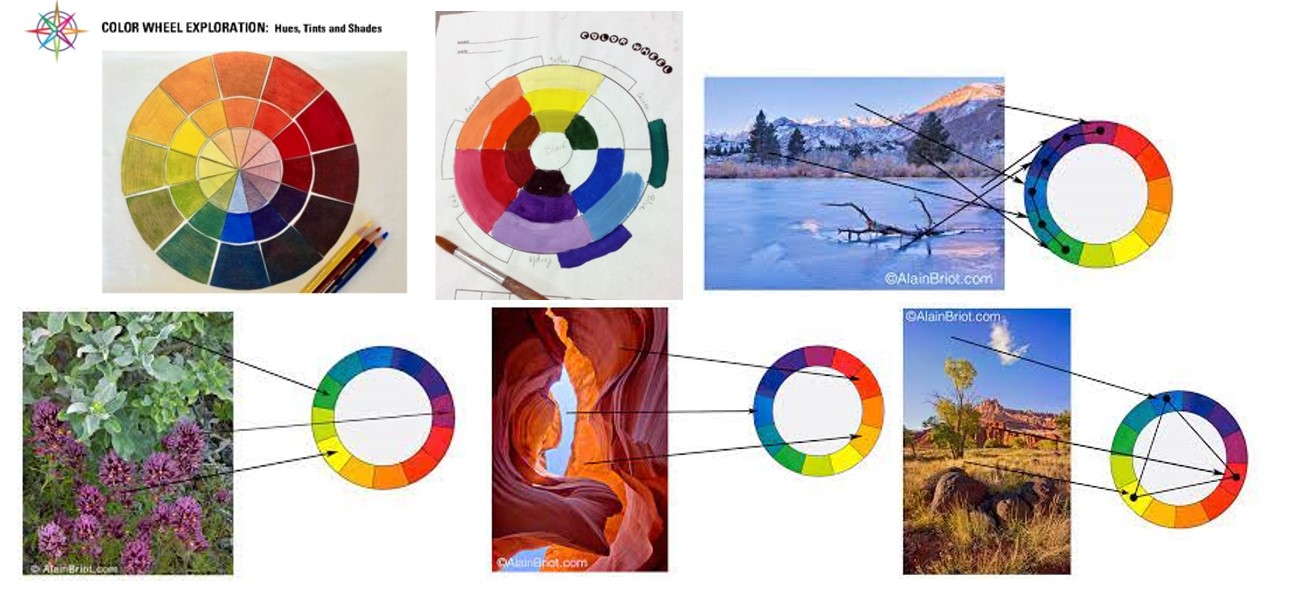Color Theory
Florida Standards
VA.912.S.3.8 Develop color-mixing skills and techniques through application of the principles of heat properties and color and light theory.
VA.912.S.1.4 Demonstrate effective and accurate use of art vocabulary throughout the art-making process.
Goals
- Students will be able to master color-mixing techniques while creating a color wheel, also understand color intensity by using tint, tone and shade.
- Students should explore a variety of artists and be able to identify artwork that exemplifies dominant color harmonies.
Targets
- Review classroom procedures and proper paint mixing techniques.
- Use only primary colors to mix all colors on the traditional color wheel.
- Use “new primary colors” to create a CMY Color Wheel
- Discuss and utilize value with acrylic paint using tint, tone and shade.
Concepts/Content
- Introduction to acrylic painting with CMY Color Wheel
- Proper procedures and maintain materials.
- Students use only “primary” colors to complete a color wheel and develop color-mixing skills.
Vocabulary
- Color wheel
- Spectrum
- Color harmonies/schemes
- Primary Secondary
- Tertiary/Intermediate
- Warm/Cool Colors
- Monochromatic colors
- Complimentary
- Split Complementary
- Analogous color
- Hue
- Intensity
- Tint, tone and shade
Formative
Peer Critiques, One-on-One Conferences, Sketchbook or Process Journals, Gallery Walks
Summative
Final Art Projects, Written Art Critiques, Artist Statement, Art Appreciation Assessments, Art Showcase or Exhibition, Final Written Reflections
ESE/ESOL
- Use non-linguistic cues, check for understanding and reinforce effort through practice. Make alterations based on lesson and individual student needs.
- Make alterations based on lesson and individual student needs.
- Allowing frequent breaks and allowing content modifications when necessary and for individual student needs.
Scaffold
- Color Theory Introduction:
- Start by teaching students the basics of color theory, including the color wheel, primary, secondary, and tertiary colors, complementary colors, analogous colors, warm and cool colors, and color harmony.
- Color Harmonies Study:
- Discuss different color harmonies, such as complementary, analogous, triadic, and split-complementary color schemes. Show examples of how these harmonies are used in art and design.
- Color Wheel Paintings:
- Understanding color mixing with acrylic paint with shades and tint.
- Nature Exploration:
- Take students on a nature walk or provide them with photographs of natural scenes, such as landscapes, flowers, or animals. Ask them to observe and note the colors they see in these scenes.
- Color Palette Creation:
- Have each student select a natural scene or element as their inspiration. Instruct them to create a color palette based on their chosen scene. They should identify and note the dominant colors and their relationships, such as complementary or analogous pairs.
- Painting Creation:
- Using their chosen color palette and the principles of color theory, students should create a painting or artwork inspired by the natural scene they selected. Encourage them to experiment with various color harmonies to see how they influence the mood and visual impact of their artwork.
- Presentation:
- Each student should present their artwork and explain the color theory principles they applied. Discuss how their choice of color harmony influenced the overall look and feel of their artwork.
- Group Discussion:
- After all presentations, hold a class discussion about the importance of color in art and the various ways color harmonies can be used to create visual interest and emotional impact.
- Reflection:
- Ask students to reflect on what they've learned about color theory and how it can be applied to their future art projects.

-1.png?width=500&height=500&name=Untitled-2%20(1)-1.png)